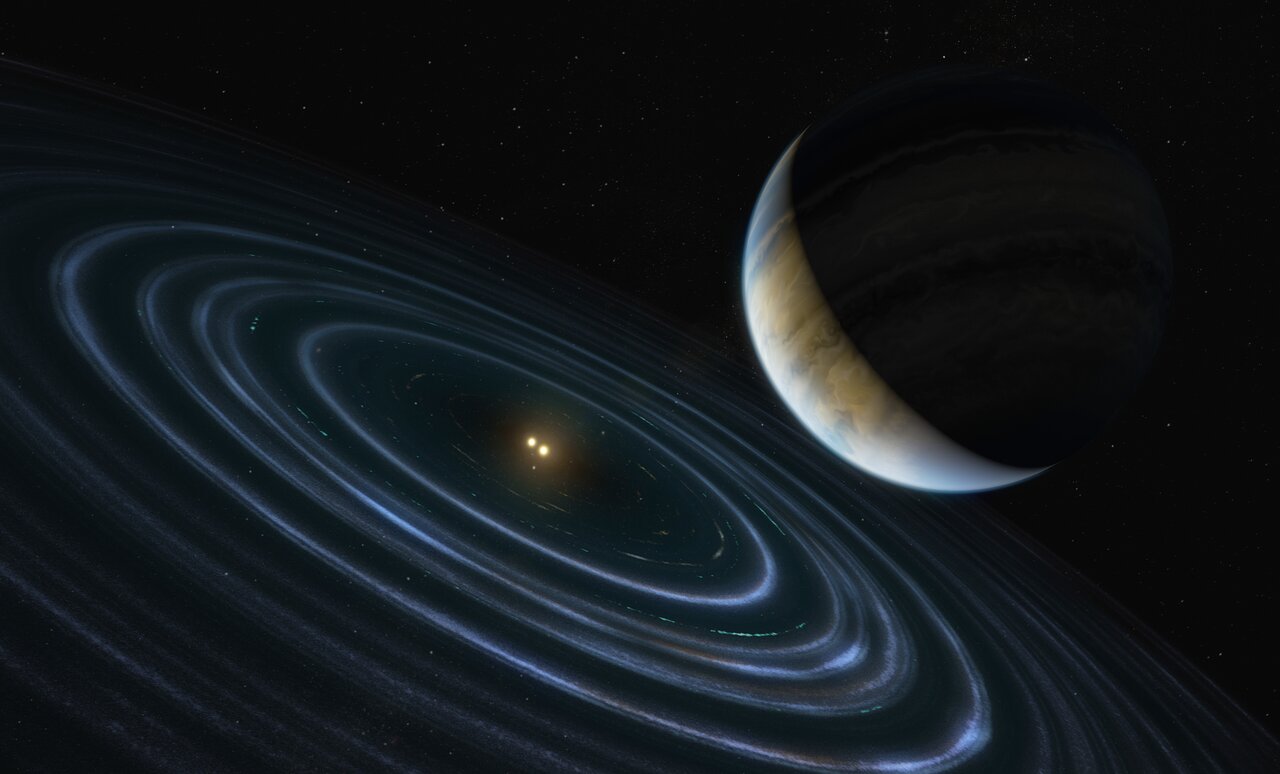Even with all we’ve learned about our own Solar System, especially in the last couple of decades, researchers still face many unanswered questions. One of those questions regards the so-called Planet Nine. The Planet Nine hypothesis states that there’s a massive planet in our Solar System orbiting at a great distance from the Sun.
Nobody’s ever observed the hypothesized planet; the evidence for it lies in a cluster of bodies that orbit the Sun 250 times further out than Earth does. These objects are called e-TNOs, for extreme Trans-Neptunian Objects. According to the hypothesis, Planet Nine’s gravity is responsible for the unusual clustered orbits of these e-TNOs.
Now astronomers have found a distant solar system with its own Planet Nine, and that discovery is breathing new life into the hypothesis.
The planet is named HD 106906 b, and it orbits a binary star 336 light-years away. It has a mass of about 11 Jupiters, and it orbits the stars at a distance of more than 730 times the distance from Earth to the Sun. That’s an extremely distant orbit.
The paper presenting these results is titled “First Detection of Orbital Motion for HD 106906 b: A Wide-separation Exoplanet on a Planet Nine–like Orbit.” The first author is Meiji M. Nguyen from the University of California, Berkeley. It’s published in The Astronomical Journal.
The story of this discovery starts back in 2004 when the Hubble first observed HD 106906 b. At that time, little was known about the system. The Hubble observations were follow-up observations aimed at indirect evidence that a warm dust disk surrounded the star, and astronomers wanted to know more about that disk.
Paul Kalas, also of UC Berkeley, is one of the authors of the new paper. In an email exchange with Universe Today, Kalas explained HD 106906 b’s interesting back story. “The first Hubble observation took place on July 24, 2004. The purpose was to follow up on indirect evidence that the central star was surrounded by a dust disk, much like our solar system has the asteroid belt and Kuiper Belt.”
“At the time, we didn’t know the star was actually a binary star, nor did we know that one of the background stars in the field of view was an extrasolar planet instead of a true background star,” explained Kalas. “What we did know is that the star HD 106906 was a source of too much infrared radiation, and we inferred that there was a warm dust disk around it.”
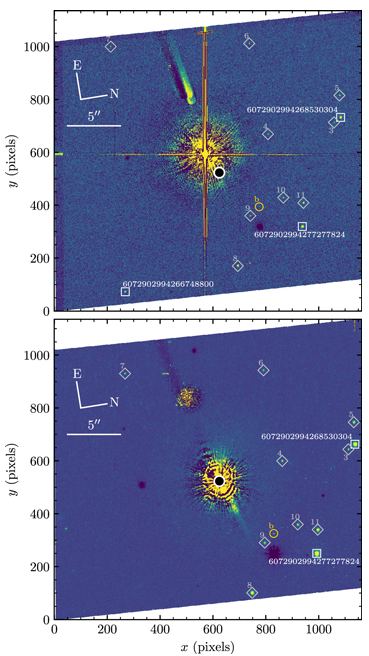
When astronomers pointed Hubble at the system in 2004 they were looking for the dust disk, but they didn’t find it, even though they were looking right at it. “The disk is so distorted, that it is difficult to recognize it as a disk and may have been mistaken for a noise artifact,” Kalas said.
They also looked right at the planet but didn’t identify it as one. Instead, they thought it was a background star, partly because it orbits at such an extreme distance from the system’s stars. “The planet is so far away from the binary star that one would naturally expect to find a background star at this distant location rather than a planet,” said Kalas.
Now the story jumps to the year 2013 when astronomers used the Magellan Telescopes at the Las Campanas Observatory in Chile’s Atacama Desert to study the system. They captured multiple images over time, which showed movement. Kalas explains: “HD 106906 (the binary star) moves across the sky relative to more distant background stars. They discovered that HD 106906 b also moved in the same direction and distance as the binary. It wasn’t a background star at all, but a giant planet physically associated with the binary.”
This is where the Gemini Planet Imager (GPI) enters the story. The GPI is an extremely advanced optics system on the Gemini South Telescope in Chile. It performs both spectroscopic and polarimetric observations. Its specialty is detecting gas giants that are relatively close to their stars, something other instruments can struggle to do. It’s also excellent at studying disks of material like the one around the binary star HD 106906.
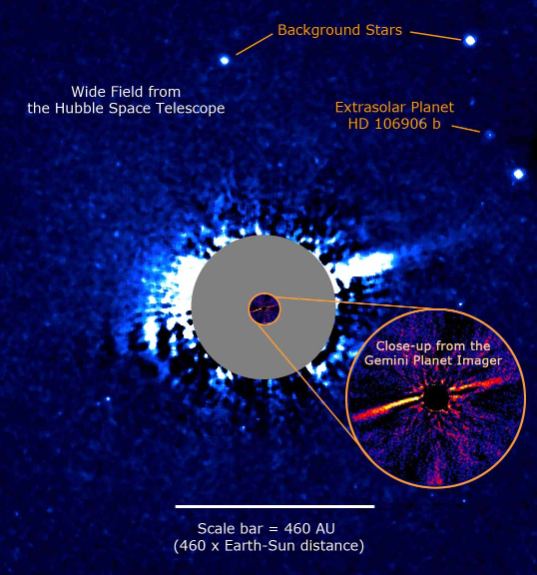
“Then, in a research paper that I led in 2015, we used an advanced ground-based instrument called the Gemini Planet Imager to directly image the dust disk surrounding the binary,” Kalas said. “Looking back at the Hubble data archive, I found that the disk had been detected 11 years earlier. It was truly a distorted planetary system rather than a noise artifact.”
Then during 2017 and 2018, astronomers again turned the Hubble towards the HD 106906 system in an effort to image the system and its disk in more detail. “I was the principal investigator of the 2017 observation,” said Kalas. “In our new work, we measured the planet’s motion relative to its host star for the first time using the 14 years of Hubble data starting from 2004 and ending in 2018. We found that one year for HD 106906 b equates to roughly 15,000 years on Earth.”
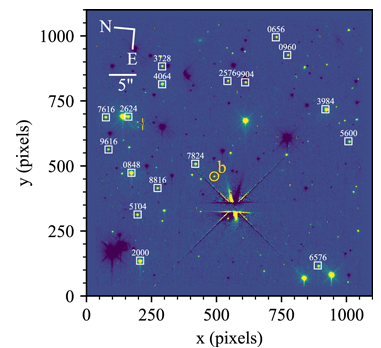
And this is where the story involves another observatory and its data: the ESA’s Gaia mission. Kalas explains: “Its tiny motion over 14 years would have been impossible to measure if it weren’t for data from another space observatory called Gaia which gave us accurate positions for the background stars, thus providing a very fine reference grid with which to measure changes in position over time.”
Astronomers think that the planet’s slow-motion orbit is due to its distance from the stars and the weak force of gravity they exert on it. The orbit is also inclined and elongated, and it’s well outside the dusty disk that surrounds the stars. The shape of the debris disk itself is also unusual, which made it difficult to detect, and that’s likely because of the gravitational tug from the planet.
“To highlight why this is weird, we can just look at our own Solar System and see that all of the planets lie roughly in the same plane,” explained lead author Nguyen in a press release. “It would be bizarre if, say, Jupiter just happened to be inclined 30 degrees relative to the plane that every other planet orbits in. This raises all sorts of questions about how HD 106906 b ended up so far out on such an inclined orbit.”
What caused this strange warped disk? The likely reason is the planet itself. It may have formed much closer to its stars than it is now, and then migrated outward. Then it was subjected to drag from the gas disk surrounding the stars, which made its orbit decay. So it actually would’ve come closer to the stars, initially.
But twin stars can have complex gravitational forces, and those forces likely kicked the planet out of its cozy position. It was almost ejected from the system, doomed to wander through interstellar space as a rogue planet. Instead, it took up an eccentric orbit. All of that activity likely warped the dust disk into its unusual shape.
Then, astronomers think, a rogue star passed by. That encounter stabilized HD 106906 b’s orbit, and the system became what we see now. The Gaia mission also identified candidate stars that could’ve been responsible, which strengthened this explanation.
There are parallels between HD 106906 b and our own Solar System’s hypothetical Planet Nine. In Planet Nine’s case, it also may have formed close to the Sun but then been evicted by interactions with Jupiter. That interaction likely ejected Planet Nine into the Solar System’s nether regions, far beyond Pluto’s orbit. A passing star may have played the same role it played in HD 106906 b’s orbit by stabilizing it.
“It’s as if we have a time machine for our own Solar System going back 4.6 billion years to see what may have happened when our young Solar System was dynamically active and everything was being jostled around and rearranged,” explained Kalas.
But a stubborn fact remains: there’s no direct evidence for Planet Nine. There’s only circumstantial evidence.
But lots of scientific developments start with not much more. Neptune was discovered with math, long before there were any direct observations. And it was discovered partly due to irregularities in the orbit of its neighbour Uranus. So orbital irregularities have led to the discovery of planets before.
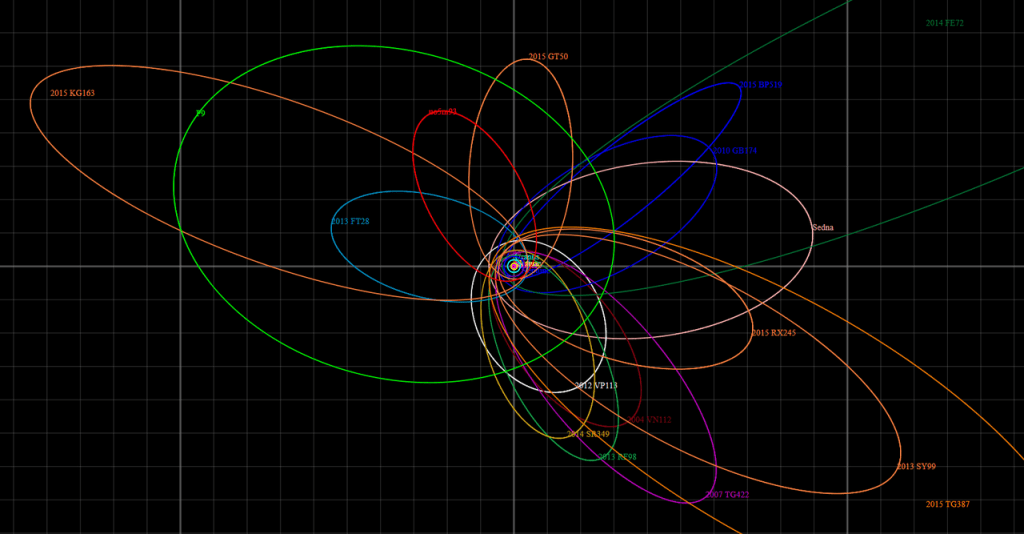
We can observe our own Solar System much easier than we can others, and we know that there are a group of bodies with unusual clustered orbits. Could there be a Planet Nine responsible for them? Maybe.
“Despite the lack of detection of Planet Nine to date, the orbit of the planet can be inferred based on its effect on the various objects in the outer Solar System,” explained team member Robert De Rosa of the European Southern Observatory in Santiago, Chile who led the study’s analysis. “This suggests that if a planet was indeed responsible for what we observe in the orbits of trans-Neptunian objects, it should have an eccentric orbit inclined relative to the plane of the Solar System. This prediction of the orbit of Planet Nine is similar to what we are seeing with HD 106906b.”
The Planet Nine hypothesis is only one possible explanation. Some astronomers think that the combined mass of the eTNOs could be providing the necessary gravity for their orbits. Others propose that Planet Nine could actually be a primordial black hole rather than a planet. Others think that there could be observational bias at work here, and the orbital clustering of eTNOs is only part of the picture.
But the discovery of HD 106906 b is certainly casting new light on the Planet Nine hypothesis. We now know that a large planet can end up in an extremely wide orbit. Next, maybe we can detect HD 106906 b’s own little flock of bodies whose orbits have been shaped by its presence. But that’s likely well out of reach of our observations.
“There are still a lot of open questions about this system.”
Robert De Rosa, co-author, ESO.
Better yet, maybe we’ll actually observe Planet Nine. But for that, we may have to wait for another leap in observing capabilities.
As for the HD 106906 system, we could only be in the beginning of studying it, and there are lots of unanswered questions.
“There are still a lot of open questions about this system,” added De Rosa. “For example, we do not conclusively know where or how the planet formed. Although we have made the first measurement of orbital motion, there are still large uncertainties on the various orbital parameters. It is likely that both observers and theorists alike will be studying HD 106906 for years to come, unravelling the many mysteries of this remarkable planetary system.”
More:
- Press Release: Hubble Identifies Strange Exoplanet That Behaves Like the Long-Sought “Planet Nine”
- Published Research: First Detection of Orbital Motion for HD 106906 b: A Wide-separation Exoplanet on a Planet Nine–like Orbit
- Universe Today: If Planet 9 is a Primordial Black Hole, We Might Be Able to See Flares When it Consumes Comets

